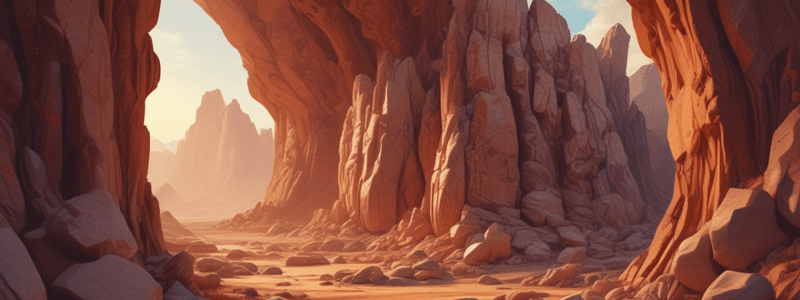Podcast
Questions and Answers
What is the primary difference between detrital and chemical sedimentary rocks?
What is the primary difference between detrital and chemical sedimentary rocks?
- Their color and texture
- Their hardness and durability
- The way they are transported and deposited (correct)
- The size of the particles that form them
What is the term for the process of creating both detrital and chemical sedimentary rocks?
What is the term for the process of creating both detrital and chemical sedimentary rocks?
- Lithification (correct)
- Sedimentation
- Compaction
- Cementation
What is the primary cause of compaction in the formation of sedimentary rocks?
What is the primary cause of compaction in the formation of sedimentary rocks?
- Minerals precipitating from solution
- The movement of tectonic plates
- Water filtering through the rock
- The weight of overlying layers (correct)
What is the role of minerals in the cementation process?
What is the role of minerals in the cementation process?
What is the typical order of the lithification process?
What is the typical order of the lithification process?
What is the term for the texture or pattern retained in a sedimentary rock that was formed by the process that deposited the original sediment?
What is the term for the texture or pattern retained in a sedimentary rock that was formed by the process that deposited the original sediment?
What type of rocks are formed from sediment, or detritus shed from pre-existing rocks?
What type of rocks are formed from sediment, or detritus shed from pre-existing rocks?
What determines the texture of a detrital sedimentary rock?
What determines the texture of a detrital sedimentary rock?
What is the term for the uniformity of grain size in a detrital sedimentary rock?
What is the term for the uniformity of grain size in a detrital sedimentary rock?
What is the significance of the texture and composition of a detrital sedimentary rock?
What is the significance of the texture and composition of a detrital sedimentary rock?
What happens to the river's flow and energy when it exits the mountains?
What happens to the river's flow and energy when it exits the mountains?
What is the characteristic of the sedimentary rock formed from the remaining sediment deposited by the river when it meets the ocean?
What is the characteristic of the sedimentary rock formed from the remaining sediment deposited by the river when it meets the ocean?
What is the primary difference between conglomerate and breccia sedimentary rocks?
What is the primary difference between conglomerate and breccia sedimentary rocks?
What is the process by which organic chemical sedimentary rocks are formed?
What is the process by which organic chemical sedimentary rocks are formed?
What is the characteristic of micritic limestone formed in the ocean?
What is the characteristic of micritic limestone formed in the ocean?
Flashcards are hidden until you start studying
Study Notes
Sedimentary Rocks
- Sedimentary rocks are made of different components transported and deposited on the earth's surface.
Detrital vs Chemical Rocks
- Detrital or clastic sedimentary rocks form from the transportation and deposition of sediment and rock fragments.
- Chemical sedimentary rocks form from the transportation and precipitation of ions in a solution.
Lithification Process
- Lithification is the process of creating sedimentary rocks, containing three key steps: deposition, compaction, and cementation.
- Deposition: sediment and rock fragments are transported and deposited in a new location.
- Compaction: sediment is compressed by the weight of overlying material, causing grains to stick together.
- Cementation: minerals from surrounding water fill in spaces between grains, holding them together.
Depositional Features
- Depositional features are textures or patterns preserved in sedimentary rocks, providing clues to their formation environments.
- Examples of depositional features: ripple marks, sand dune cross-beds, mud cracks, and fossils.
Detrital Sedimentary Rocks
- Detrital sedimentary rocks form from sediment or detritus shed from pre-existing rocks.
- Also known as clastic sedimentary rocks, made of fragments of past rocks.
- Formed through erosion, transportation, and deposition of rock fragments.
Texture and Composition of Detrital Rocks
- Texture determined by grain size, sorting, and roundness.
- Grain size: clay, silt, sand, pebble, cobble, and boulder.
- Grain sorting: uniformity of grain size in the rock.
- Grain roundness: angular, subangular, subrounded, rounded, and well-rounded.
- Composition: uniformity in the composition of the rock's grains.
Common Detrital Sedimentary Rocks
- Shale or claystone: made up of well-sorted, clay-sized particles.
- Siltstone: made up of well-sorted, silt-sized particles.
- Sandstone: made up of sand-sized particles.
- Conglomerate: contains particles larger than sand, grains are sub-angular to rounded and can be very poorly to well-sorted.
- Breccia: contains particles larger than sand, grains are angular to sub-angular and usually very poorly sorted.
Chemical Sedimentary Rocks
- Form from grains that precipitate out of a water solution through organic or inorganic processes.
- Organic chemical rocks: formed from ocean organisms that pull compounds out of solution to create shells or skeletal structures (e.g., limestone and chert).
- Inorganic chemical rocks: formed when ions become oversaturated in a solution and precipitate as particles or mineral grains (e.g., micritic limestone, evaporite minerals like halite, gypsum, and anhydrite).
Studying That Suits You
Use AI to generate personalized quizzes and flashcards to suit your learning preferences.




